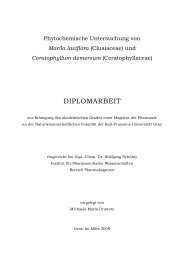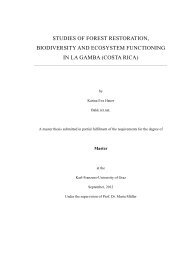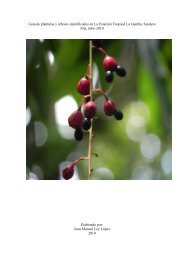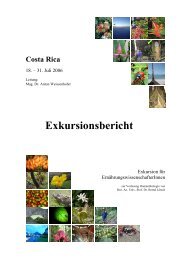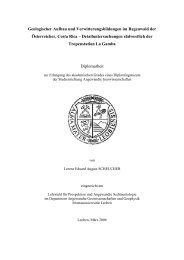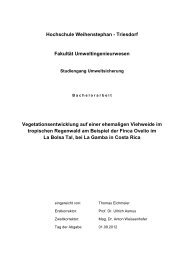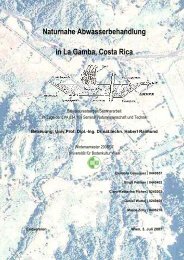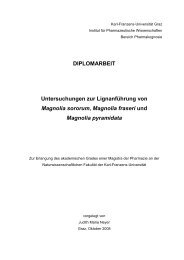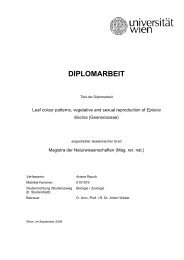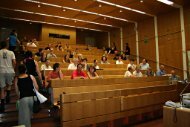Die Tropenstation La Gamba
Die Tropenstation La Gamba
Die Tropenstation La Gamba
Erfolgreiche ePaper selbst erstellen
Machen Sie aus Ihren PDF Publikationen ein blätterbares Flipbook mit unserer einzigartigen Google optimierten e-Paper Software.
<strong>Die</strong> „<strong>Tropenstation</strong> <strong>La</strong> <strong>Gamba</strong>“ in Costa Rica – Wissenschaftlicher Bericht<br />
KASTINGER, C., WEBER, A., 1999: Attraction of hummmingbirds by extrafloral cues<br />
in some Costa Rican species of Columnea (Gesneriaceae). - 14. Symp. Biodiv.<br />
Evolutionsbiol. Jena 1999: 94.<br />
Attraction and pollination of species of Columnea is currently studied in the<br />
Bosque Esquinas, a tropical lowland rain forest in the South of Costa Rica. Six species<br />
have been recorded and studied in the area, all growing as epiphytes on tree branches,<br />
tree trunks and rocks: C. angustata, C. flaccida, C. florida, C. polyantha, C. raymondii,<br />
and C. segregata.<br />
The flowers of Columnea have usually a large and conspicuously colored<br />
corolla adapted to pollination by hummingbirds. Three of the species listed belong to<br />
this type: C. flaccida and C. raymondii have large, bright red flowers of a strongly<br />
dorsiventral shape ('galeate' type ), while C. angustata has tubular flowers with a yellow<br />
corolla and a red calyx. In the latter species it is also the colour contrast that is operative<br />
for attraction.<br />
In contrast, C. segregata, C. florida and C. polyantha have small, yellowish,<br />
and tubular flowers which are rather inconspicuous, hidden below the leaves and not<br />
suitable to attract hummingbirds from a long distance. These plants have developed<br />
different strategies for long distance attraction: attraction by conspicuous leaf markings.<br />
C. segregata has two to several red blotches on the undersurface of the leaves.<br />
The leaves are strongly anisophyllous and pale green on the lower side. The red blotches<br />
are not sharply circumscribed and are located in the upper half of the leaves. The plants<br />
were frequently visited by Threnetes ruckeri, the 'Band-tailed Barbthroat'. The birds<br />
have to fly below the plant to be able to find the plant and its flowers, and then they are<br />
lured by the red color patterns. When a flowering plant is located, periodical visits of the<br />
same bird follow.<br />
C. florida has two red blotches near the apex of the leaves, well bordered by<br />
blackish margins. The tissue of the central red areas is very thin and translucent. In this<br />
species the visitation by hummingbirds and the principal role of the red blotches for<br />
attraction was described by Jones & Rich [Bull. S. Calif. Acad. Sci. 71: 113-116<br />
(1972)], but these authors failed to notice the significant window-effect: the red blotches<br />
are only visible from below and particularly attractive when light falls through the<br />
leaves.<br />
C. polyantha apparently has another strategy of attracting pollinators, which is<br />
also operative when the birds fly a b o v e the plant: the leaves are densely covered with<br />
semi-erect, reddish hairs. These hairs are positioned at a constant angle to the leaf<br />
surface. In 'normal' position the leaves appear green, but when seen from a certain angle,<br />
they turn red by the hair cover. The leaves thus twinkle for a fraction of a second in a red<br />
colour when the bird flies over or nearby the plant. The short emission of the signal<br />
apparently enhances the colour effect. C. polyantha was mainly visited by Phaetornis<br />
superciliosus, the 'Long-tailed Hermit'.<br />
Hummingbirds generally have a very good memory and they clearly remember<br />
their diet-plants. In addition, many species follow certain routes in the forest (traplining).<br />
The long-distance attraction by the extrafloral markings is most important for the first<br />
attraction, leading the bird to find a new diet-plant. Pollination of subsequent flowers is<br />
achieved mainly by the traplining behaviour.<br />
Anschrift der Autoren:<br />
Mag. Christoph Kastinger & Univ. Prof. Dr. Anton Weber<br />
Inst. f. Botanik, Rennweg 14, A-1030 Wien,<br />
Tel. ++43-1-4277-54083<br />
Fax. ++43-1-4277-9541<br />
anton.weber@univie.ac.at - christoph.kastinger@univie.ac.at<br />
75



